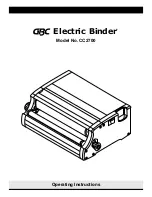
|
152
|
KX-F910BX
5-2.MODEM CIRCUIT OPERATION
The modem (IC11) has all the hardware satisfying the ITU-T standards mentioned previously.
When the gate array IC1 (116) is brought to low level, the modem (IC11) is chip-selected and resistors inside IC are selected
by select signals from ASIC (IC1) A0-A4, commands are written through data bus, and all processing is controlled at the ASIC
(IC1) according to ITU-T procedures. Here the signal INT dispatched from IRQ (pin 52 of IC11) to the ASIC (IC1) when
preparation for acceptance of transmission data is OK and when demodulation of reception data is complete, the ASIC (IC1)
implements post processing. This modem (IC11) has an automatic application equalizer. With training signal 1 or 2 at time of
G3 reception, it can automatically establish the optimum equalizer. Also, the modem (IC11) generates an internal clock of
24.00014MHz by means of an external crystal oscillator (X1).
(1) Facsimile Transmission/DTMF Line Send
The digital image data on the data bus is modulated in the modem (IC11), and sent from pin 44 via amplifier
IC10 (6
¤
7), the NCU section to the telephone line.
IC11 (44)
¤
C73
¤
R90
¤
IC10(6-7)
¤
CN1(10)
¤
CN271(10)
¤
C184
¤
R182
¤
IC151(73-63)
¤
¤
C74
[C203
¤
R210
¤
IC201(2-1)
¤
C202
¤
R201
¤
T101]
¤
TEL LINE.
[ ]: NCU section
(2) Facsimile Reception
The analog image deta Which is received from the telephone line passes through the NCU section and enters pin 45 of the
modem (IC11). The signals that enter pin 45 of the modem (IC11) are demodulated in the board to digital image signals,
then placed on the data bus.
In this case, the image signals from the telephone line are transmitted serially, Hence they are placed on the bus in 8 bit
units. Here, internal the equalizer circuit reduces the image signals to the long-distance receiving level.
It is designed to correct the characteristics of the frequency band centered about 3 kHz and maintain a constant receiving
sensitivity. It can be set in the service mode.
TEL.Line
¤
T101
¤
R202
¤
C205
¤
IC201(6-7)
¤
C210
¤
C212
¤
R215
¤
C213
¤
IC202(1-2)
¤
C217
¤
CN271(9)
¤
R11
¤
IC10(2-1)
¤
C19
¤
R13
¤
IC11(45)
(3) DTMF Transmission (Monitor tone)
The DTMF signal generated in the modem (IC11) is output from pin 44, then passes through the analog G/A IC151, and
the NCU section to the telephone line as same as facsimile transmission signals.
(DTMF Monitor Tone)
IC11 (44)
¤
C73
¤
R90
¤
IC10(6-7)
¤
CN1(10)
¤
CN271(10)
¤
C184
¤
R184
¤
IC151(76-41)
¤
C158
¤
R161
¤
¤
C74
IC151 (40-38)
¤
R245
¤
C245
¤
IC241(4-5,8)
¤
Speaker
(4) Call Tone Transmission
The call signal which is generated in the ASIC (IC1) passes through analog G/A IC151 and IC241 (4
¤
8, 5) to the speaker.
IC1
(85,87)
¤
R59
¤
C56
¤
CN2(1)
¤
CN272(1)
¤
R186
¤
C187
¤
IC151(78-41)
¤
C158
¤
R161
¤
¤
R60
¤
C57
IC151 (40-38)
¤
R245
¤
C245
¤
IC241(4-5,8)
¤
Speaker
(5) Busy/Dial Tone Detection
The path is the same as for FAX receiving. When it is detected, the carrier detect bit of the resistor in the modem
(IC11) becomes 1, and this status is monitored by the ASIC (IC1).
Summary of Contents for KX-F910BX
Page 1: ......
Page 176: ......
Page 177: ......
Page 178: ......
Page 179: ......
Page 180: ......
Page 181: ......
Page 182: ......
Page 183: ......
Page 184: ......
Page 185: ......
Page 186: ......
Page 187: ......
Page 188: ......
Page 189: ......
Page 190: ......
Page 191: ......
Page 192: ......
Page 193: ......
Page 194: ......
Page 195: ......
Page 196: ......
Page 197: ......
Page 198: ......
Page 199: ......
Page 200: ......
Page 201: ......
Page 202: ......
Page 203: ......
Page 204: ......
Page 205: ......
Page 206: ......
Page 207: ......
Page 208: ......
Page 209: ......
Page 217: ......
















































